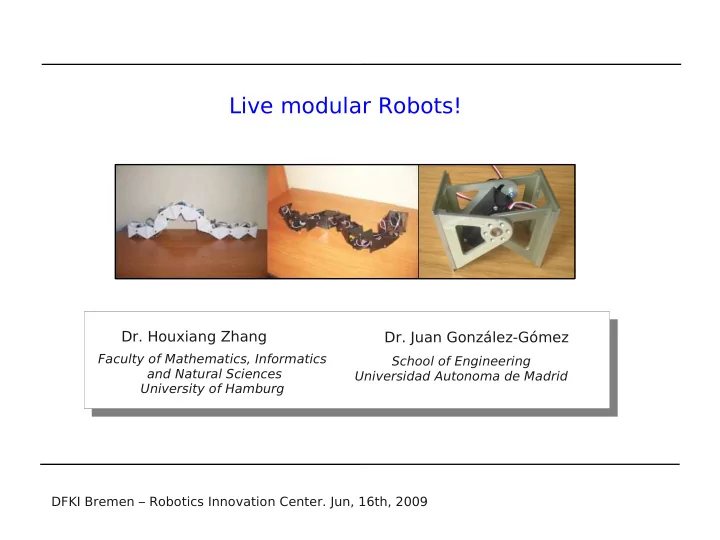

Live modular Robots! Dr. Houxiang Zhang Dr. Juan González-Gómez Faculty of Mathematics, Informatics School of Engineering and Natural Sciences Universidad Autonoma de Madrid University of Hamburg DFKI Bremen – Robotics Innovation Center. Jun, 16th, 2009
Outline Outline 1. Introduction 2. Locomotion in 1D 3. Locomotion in 2D 4. Minimal configurations 5. Cube-M modules 6. Conclusions and current work 2 Live modular Robots! DFKI Bremen – Robotics Innovation Center. Jun, 16th, 2009
The Locomotion Problem Modular approach Bio-inspired approach Classic approach CMU Ambler Aramies Polybot Big Dog Dante II 3
Modular Robotics ● Two important aspects: ● Robot morphology ● Controller 4
Morphology Modular Robot classification 2D Topology 3D Topology 1D Topology 1D topology sub-classification Pitch-yaw Yaw-yaw Pitch-Pitch 5
Controller ● Coordination problem : Calculation of the joint's angles to realize a gait: i t ● Classic approach : Mathematical modeling ● Calculation by inverse kinematics ● Disadvantages: The equations are only valid for an specific morphology CPG CPG CPG ● Bio-inspired controllers : CPGs ● Central Pattern Generators ● CPGs control the rhythmic activities ● Ej. The locomotion of the lamprey 6
Hypothesis: Sinusoidal oscillators ● CPGs are replaced by a Simplified model CPG CPG CPG ● Sinusoidal oscillators: ● Advantages : in 2 i t = A i s T i O i ● Few resources required 7
Outline Outline 1. Introduction 2. Locomotion in 1D 3. Locomotion in 2D 4. Minimal configurations 5. Cube-M modules 6. Conclusions and current work 8 Live modular Robots! DFKI Bremen – Robotics Innovation Center. Jun, 16th, 2009
Y1 Modules ● One degree of freedom ● Easy to build ● Cheap ● Open and “Free” 9
Electronics & control 10
Cube Revolutions (I) Videos ● Morphology: 8 modules with pitch-pitch connection ● Controller: ● 8 equal oscillators ● Parameters: A , ,T 11
Locomotion mechanism ● Locomotion performed by the body wave propagation x ● Step: V = x ● Mean Speed: T ● Serpenoid curve ● Step calculation: l x = l s 2 k k c k −∫ 0 o s c o s ds l 12
Outline Outline 1. Introduction 2. Locomotion in 1D 3. Locomotion in 2D 4. Minimal configurations 5. Cube-M modules 6. Conclusions and current work 13 Live modular Robots! DFKI Bremen – Robotics Innovation Center. Jun, 16th, 2009
Hypercube (I) Demo ● Morphology 8 modules with pitch-yaw connection ● Controller: ● 4 vertical oscillators ● 4 horizontal oscillators ● Parameters: A h ,A v , h , v , vh ,T 14
Locomotion gaits ● Searching : Genetic algorithms ● 5 categories of gaits ● Characterized by the 3D body wave 15
Locomotion mechanism ● 3D Body wave propagation r ● Linear Step: ● Angular Step: ● Dimensions: width (w) x length (lx) x heigth (h) 16
Outline Outline 1. Introduction 2. Locomotion in 1D 3. Locomotion in 2D 4. Minimal configurations 5. Cube-M modules 6. Conclusions and future work 17 Live modular Robots! DFKI Bremen – Robotics Innovation Center. Jun, 16th, 2009
Minimal configurations ● Configurations with the minimal number of modules that are able to move ● Searching the control space using genetic algorithms ● 5 gaits ● Straight line 18
Minicube-I Demo ● Morphology 2 modules with a Pitch- pitch connection ● Controller: ● Two generators ● Parameters: A , ,T 19
Minicube-II Demo ● Morphology: 3 modules with Pitch-yaw- pitch connection ● Controller: ● 3 oscillators ● Parameters: A v ,A h , v , vh ,T 20
Locomotion gaits Rolling Forward Lateral shifting A v = 40, A h = 0 A v = A h 40 vh = 90, v = 0 v = 120 A v = A h 60 Turning vh = 90, v = 0 Rotating A v = 40, A h = 0 A v = 10, A h = 40 O h = 30, v = 120 21 vh = 90, v = 180
Outline Outline 1. Introduction 2. Locomotion in 1D 3. Locomotion in 2D 4. Minimal configurations 5. Cube-M modules 6. Conclusions and current work 22 Live modular Robots! DFKI Bremen – Robotics Innovation Center. Jun, 16th, 2009
Cube-M module(I) Low cost mechanical design ● Simple robust modules assembling ● manually and int a quick-to-build, easy-to- handle design Onboard electronics and sensors ● 23
Cube-M module (II) Demo 24
Software Demo ● 1D topology simulator (Based on Open Dynamics Engine [ODE]) ● Generics algorithms: PGAPack ● Mathematical models in Octave/Matlab 25
Outline Outline 1. Introduction 2. Locomotion in 1D 3. Locomotion in 2D 4. Minimal configurations 5. Cube-M modules 6. Conclusions and current work 26 Live modular Robots! DFKI Bremen – Robotics Innovation Center. Jun, 16th, 2009
Conclusions The controller based on sinusoidal oscillators is valid for the locomotion of the 1D-topology modular robots ● Very few resources are required for its implementation ● The locomotion gaits are very smooth and natural ● At least 5 different gaits can be achieved i t = A i sin 2 T i O i 27
Current work Locomotion of 2D Climbing caterpillar Topology modular robots Modular grasping New module design 28
Live modular Robots! Dr. Houxiang Zhang Dr. Juan González-Gómez Faculty of Mathematics, Informatics School of Engineering and Natural Sciences Universidad Autonoma de Madrid University of Hamburg 29 DFKI Bremen – Robotics Innovation Center. Jun, 16th, 2009
Recommend
More recommend